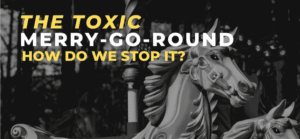Stop the Toxic Merry-Go-Round
"My job now is to try and help people understand every one of us makes a difference. And cumulatively, wise choices in how we act each day can begin to change the world." – Dr. Jane Goodall
 More than 4,500 PFCs, also known as polyfluorinated compounds, have been a man-made source of toxicity for nearly a century. None of these compounds have been proven safe in our food, water, soil, or air. Each is merely another version of the same problem, with another brand name or abbreviation. Although a few have been removed from the market, this only applies to new manufacturing. Products containing these discontinued PFCs and the environmental contamination caused by them remain everywhere. Regrettably, PFAS substances (per- or poly-fluoroalkyl substances) – the majority of all PFCs - have not been discontinued. The serious consequences to our health continue to escalate as these toxins accumulate in everything we touch and ingest. And because PFCs – especially PFAS - are so durable, the impact on our children will be even greater.
More than 4,500 PFCs, also known as polyfluorinated compounds, have been a man-made source of toxicity for nearly a century. None of these compounds have been proven safe in our food, water, soil, or air. Each is merely another version of the same problem, with another brand name or abbreviation. Although a few have been removed from the market, this only applies to new manufacturing. Products containing these discontinued PFCs and the environmental contamination caused by them remain everywhere. Regrettably, PFAS substances (per- or poly-fluoroalkyl substances) – the majority of all PFCs - have not been discontinued. The serious consequences to our health continue to escalate as these toxins accumulate in everything we touch and ingest. And because PFCs – especially PFAS - are so durable, the impact on our children will be even greater.
PFAS substances account for over 3,000 of all PFCs and are found in countless consumer goods and commercial operations. These substances entered our world as "solutions" for making surfaces smooth, reducing friction, resisting stains, and repelling water. According to multiple studies and manufacturer disclosures, examples of products that contain PFAS include the following:
- clothing and furniture made to be stain-resistant, waterproof, or fire-resistant
- formed plastics made to look like cloth, such as car upholstery or shoes
- floor polishes and stain-resistant carpeting
- wide variety of adhesives, ranging from household tape to industrial
- firefighting foams, equipment, and work uniforms
- insulation for electrical wires
- paper and plastics used for food packaging such as squeeze bottles, "K-cups," pizza boxes, microwave popcorn bags, fast food wrappers, and "to-go" boxes
- personal care products, such as shampoo and dental floss
- heat-resistant and non-stick coatings on cookware and cooking utensils
Bioaccumulation of PFCs has been verified in blood banks, employee blood samples, and random human blood samples going back to the 1970s. Despite the undeniable and growing human exposure to PFCs, which includes PFAS, the first regulatory exposure limits for PFCs were not issued until the early 2000s! The response of the chemical and manufacturing industries has been a succession of substitute PFCs, with each new version claiming to be safer than the prior one. But each new version has only been a different horse on the toxic merry-go-round.
Regulation of PFAS substances has finally begun, but the pace is painfully slow. The EPA has announced its intention to issue regulatory limits on PFAS in drinking water by the end of 2023. Some manufacturers (3M and others) have announced their intention to eliminate PFAS and related substances from their products by 2025. Some European and Asian governments have banned a variety of PFCs, including PFAS, from products manufactured in their countries - but not none have banned the import of PFAS-containing products. Until PFCs and PFAS are banned by all countries, every citizen should be able to purchase affordable and toxin-free goods.
 Complicating efforts to avoid PFAS-containing products is the lack of labeling requirements. Unlike allergy labeling on foods and beverages, there is no requirement to inform consumers about the presence of PFAS or any other PFC that is in, on, or may have touched a product. Not even if the product is used by an infant or a seriously ill person. In a study by The Silent Spring Institute, labels from 99 different product categories known to include both PFAS-containing and PFAS-free options were evaluated – product categories that would allow consumers to make a safe choice. The result? None of the PFAS-containing products included labeling disclosed the presence of PFAS, eliminating the possibility of making a safer purchase. Worse, the PFAS-free products had no consistent standard or verification for the claim of being PFAS-free. This is consistent with the findings of a different study published by the American Chemical Society. Researchers in that study examined 37 "green" products, and despite the claims of being "green," PFAS was found in the coating, packaging, or the product itself for all 37 items.
Complicating efforts to avoid PFAS-containing products is the lack of labeling requirements. Unlike allergy labeling on foods and beverages, there is no requirement to inform consumers about the presence of PFAS or any other PFC that is in, on, or may have touched a product. Not even if the product is used by an infant or a seriously ill person. In a study by The Silent Spring Institute, labels from 99 different product categories known to include both PFAS-containing and PFAS-free options were evaluated – product categories that would allow consumers to make a safe choice. The result? None of the PFAS-containing products included labeling disclosed the presence of PFAS, eliminating the possibility of making a safer purchase. Worse, the PFAS-free products had no consistent standard or verification for the claim of being PFAS-free. This is consistent with the findings of a different study published by the American Chemical Society. Researchers in that study examined 37 "green" products, and despite the claims of being "green," PFAS was found in the coating, packaging, or the product itself for all 37 items.
Until there is true oversight of PFAS and all related substances, manufacturers are able to add the "PFAS-free" label to their products without regulated standards or penalties. Some may self-certify, while others may have their products tested by a laboratory or apply to a third-party organization for PFAS-free verification. Two reputable organizations maintaining lists of PFAS-free products, retailers, and packaging policies are listed below:
- Clean Production Action (https://www.cleanproduction.org/resources/entry/pfas) – listings of food packaging, food production, and food service items verified to be PFAS-free
- PFAS Central (https://pfascentral.org/pfas-free-products/) – listings of brands, products, retailers, and manufacturers that are verified PFAS-fee
While the world waits for regulators and consumer protection agencies to impose PFAS exposure limits and testing requirements, individual consumers must protect their health and the health of their loved ones. The power of purchase is in our hands. Support ethical merchants by favoring the vendors, retailers, brands, and manufacturers who verify products as PFAS-free by third-party testing or verification. Champion the organizations working to advance PFAS-free technologies and PFAS regulation. Stop the toxic merry-go-round and give our children the gift of a healthier world.
About the Authors:

Allison A. Sakara, NP, MSN, RN, PHRN
Allison A. Sakara, NP, MSN, RN, PHRN, is a nurse practitioner with decades of experience in pediatrics, hematology/oncology, and disaster response. Allison is the Co-Founder & Executive Director of the High Alert Institute, a 501c3 not-for-profit educational public charity dedicated to providing disaster readiness education and resources to unserved and underserved communities, industries, and charitable organizations in an All Hazards, One Health/One Nature, One Framework paradigm. Learn more about the High Alert Institute at www.HighAlertInstitute.org

Alyssa Middleton, Ph.D
Alyssa Middleton, Ph.D., has over 20 years of experience working with cancer patients and their families and conducting cancer research. She is the co-author of Five Bugles Institute's PFAS remediation and replacement educational program. Learn more about Five Bugles Institute's research at www.fivebuglesinstitute.com/pfas

